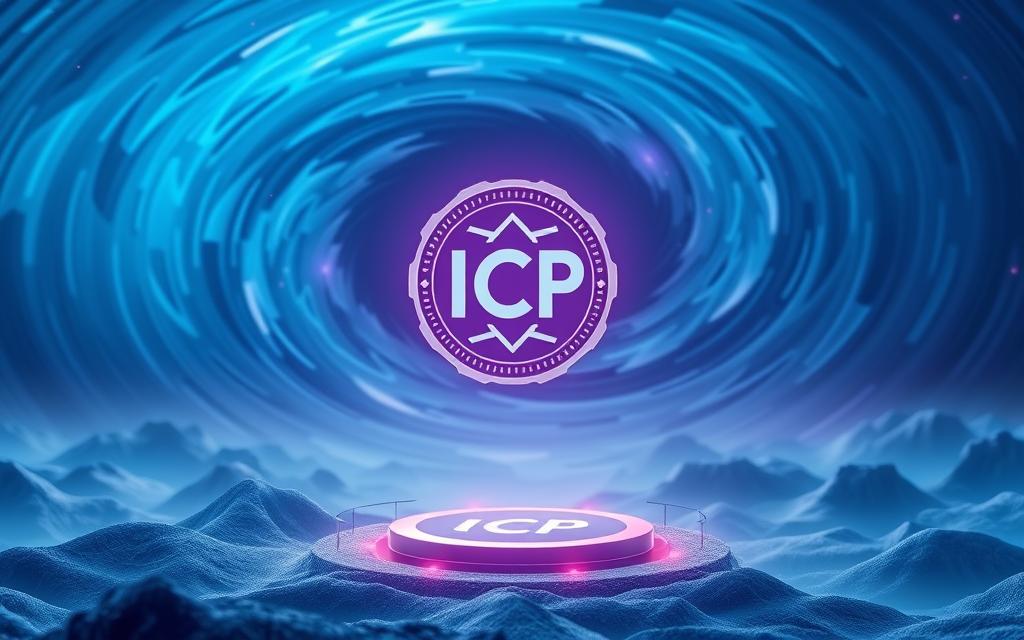is icp crypto dead frames a blunt question many investors ask after a dramatic launch and steep retracement. The Internet Computer debuted in May 2021 near $500, spiked toward a circa $700 high and briefly entered the Top 10. That rapid repricing and the later plunge toward lows around $14.88 set a high-risk baseline for readers weighing future prospects.
This piece will weigh facts over hype. It examines governance, developer activity and product rollouts as signals that matter more than headline moves. March 2025 data shows a price of $5.39, market capitalisation near $2.58 billion and a supply of about 530.28 million.
The DFINITY Foundation, a Swiss non-profit, remains the steward noted at WEF 2020 with a LinkedUp demo. We will map technical catalysts, capital flows and scenario outcomes so US readers can judge platform durability in a global context and the wider world of digital assets.
At a glance: ICP’s current state and why this question matters now
Market figures and developer signals paint a different picture than headlines suggest.
Key metrics (12 March 2025) show a market cap of $2.58 billion, a 24‑hour volume near $85.73 million and a total supply of 530.28 million tokens. The ICP price sat at $5.39, while ecosystem counts topped 200 projects.
Renewed interest follows public demos of Caffeine AI and a product narrative called “Self‑Writing Internet.” Social media chatter brought retail and professional investors back to the story.
https://www.youtube.com/watch?v=U0buy2fe4xc
The network launched on 10 May 2021 and has weathered cycles. At this time, 1,452 node machines run under 126 providers, signalling meaningful decentralisation at the infrastructure layer.
- Development activity and upgrades continue, so calling the project finished would be premature.
- Liquidity and trend strength have recovered at stages since late 2023, prompting reassessment.
- Decision points: production readiness, governance maturity and token economics alignment with user growth.
| Metric | Value | Context | Implication |
|---|---|---|---|
| ICP price | $5.39 | 12 Mar 2025 | One datapoint among many |
| Market cap | $2.58bn | On‑chain valuation | Suggests meaningful market interest |
| Nodes | 1,452 machines | 126 providers | Robust operational scale |
| Ecosystem | 200+ projects | March 2025 | Active developer base |
From May 2021 all‑time high to price collapse: a brief history of Internet Computer
The launch week in May 2021 produced dizzying price action that few platforms had seen. Simultaneous listings on major exchanges and deep order books produced rapid price discovery. ICP debuted near $500 and spiked toward a circa $700 all‑time high within hours.
Launch dynamics: listings, top‑10 debut, and the $700 ATH
Multiple venue openings created immediate liquidity pockets and volatile fills. Early trading saw averages near $300 in the first month as speculators, momentum traders and new exchange buyers chased the move.
DFINITY announced a broad global footprint — over 1,000 independent nodes across data centres — and had raised roughly $100M at a $9.5B valuation from top Silicon Valley backers. That narrative drove attention and fast flows from retail and institutional investors.
Descent and drawdown: market cycle headwinds and liquidity pressure
Post‑launch, token unlock schedules and concentrated liquidity on a few venues created sell pressure. Illiquidity pockets magnified swings and helped turn early exuberance into a sharp drawdown.
“Markets often prize narrative over product at first; time and delivery tell the rest.”
Within weeks the token slipped out of the Top 10 as broader market risk appetite cooled. Different investor cohorts — seed holders, early exchange buyers and short‑term traders — reacted on different timelines, which intensified the move.
| Event | Snapshot | Impact |
|---|---|---|
| Debut pricing | ~$500 | Rapid attention |
| ATH | ~$700 | Top‑10 listing |
| First month | ~$300 avg. | High volatility |
Rug pull or rough timing? The accusations and DFINITY’s response
Allegations around token flows and launch mechanics still shadow debate about the project’s early days.
Arkham Intelligence flagged addresses it suspects belong to treasury and insiders that moved roughly 18.9M ICP to exchanges during launch. At peak pricing that represented billions and, Arkham reported, those addresses accounted for about 75% of exchange deposits tied to the event.
The reporting raised three practical concerns: order‑book pressure from concentrated deposits, the timing of those transfers amid a rapid market sell‑off, and user friction at claim time. Seed supporters—holding near a quarter of supply—faced four‑year vesting and complex claim steps that some users found opaque.
Founder perspective and governance context
Dominic Williams responded that genesis matched the end of a major bull run; BTC tumbled from around $60k to $30k within weeks. He noted founders and executives were locked for the first week, and he personally sold far less than 5% of his holdings since genesis.
That reply does not erase concern. Exchange deposits often precede sales, yet Arkham did not show direct proof of trade execution. The concentration of transfers, however, is material when assessing early price impact.
- Vesting asymmetry: seed investors locked for years while the foundation reportedly lacked equivalent restrictions.
- User experience: technical claim procedures hindered access during peak liquidity.
- Governance: the Network Nervous Systems role in tokenomics stokes debates over control versus decentralisation on social media.
“Readers should weigh on‑chain data, founder statements and governance design before drawing firm conclusions.”
Bottom line: The dfinity foundation publicly stresses long‑term development and ecosystem growth as its rebuttal to claims that the project was mishandled. Investors should judge both the data and the founder’s account when forming a view.
Technology snapshot: how the Internet Computer network is built today
Beneath recent narratives, the internet computer combines runtime, storage and identity to run full applications on‑chain.
Canisters, Internet Identity, and the Network Nervous System (NNS)
Canisters are application units that bundle code and persistent memory. They enable stateful smart contracts that manage data storage natively on the blockchain.
Internet Identity uses WebAuthn to offer password‑free sign‑in. This privacy‑preserving approach lets users authenticate with hardware keys or platform authenticators.
The Network Nervous System is the on‑chain governance protocol. Staked ICP gives voting power. The NNS coordinates upgrades, allocates resources and can adjust tokenomics to direct control and change.
Nodes, data centres, reverse gas model, and on‑chain data storage
The infrastructure runs on independent nodes operated by multiple providers. As of March 2025 there were 1,452 node machines across 126 providers, reflecting global scale and diversity.
The reverse gas model shifts costs to developers who prepay cycles. That means end users can interact via a browser without needing tokens, improving onboarding and adoption.
Execution uses WebAssembly, so code from many languages can run natively. This lowers friction for developers and eases porting of existing applications.
- Deploying full‑stack dapps into canisters cuts operational overhead and integrates execution with data storage.
- The stack aims to build an internet‑scale computer without relying on traditional cloud providers.
- Architectural choices target seamless user experience and simpler development cycles.
| Component | Role | Why it matters |
|---|---|---|
| Canisters | App unit with code + memory | Stateful smart contracts and native data storage |
| Internet Identity | WebAuthn authentication | Password‑free sign‑in that protects privacy |
| NNS | On‑chain governance | Coordinates upgrades and control via staked ICP |
| Reverse gas | Developer‑funded cycles | Users can use apps without tokens, improving UX |
| Nodes / providers | 1,452 machines / 126 providers | Operational scale and decentralised infrastructure |
New catalysts: Caffeine AI, “Self‑Writing Internet”, and whale accumulation
Recent tooling showcased a practical route from idea to live app on the chain.
Caffeine AI turns voice or text prompts into production dapps by generating, compiling and deploying code directly into canisters. The result: prototypes that run on the internet computer without extra DevOps.
Initial proof came on 17 January 2025 in St. Moritz. An alpha followed on 3 June 2025 at the World Computer Summit in Zurich, where Dominic Williams built four live apps: an emoji landing page, a blog with tags/search, a tennis booking flow and a countdown timer.
The feature set matters for developers and users. It lowers barriers to shipping prototypes, speeds iteration and may onboard non‑developers into blockchain app creation.
Social media showed enthusiasm and pragmatic comparisons to Firebase Studio, plus scepticism over robustness for regulated or high‑scale workloads. Reports also noted historic peaks in ICP holders and whale accumulation tied to renewed interest.
- Architectural note: deploying without relying on external pipelines fits the built internet computer model.
- Risk: AI‑written code needs stronger guardrails for permissioning, data integrity and safe updates.
“Caffeine AI is an early catalyst that can seed new dapps and proofs‑of‑concept.”
Market and price trend analysis (present): where ICP stands now
Trading patterns since mid‑2022 set a framework to judge momentum and risk.
Since May 2022 the token traded inside a clear channel with support at $2.85 and resistance near $9.779. December 2023 brought a breakout on rising volume, followed by a constructive retest of prior resistance and a rebound.
Channel breaks, moving averages, and key resistance levels
As of 12 March 2025 the market sits above the 50, 100 and 200‑day moving averages. That alignment keeps momentum constructive while those moving averages hold on closing bases.
Key levels to monitor: immediate upside resistance at $14.816. Use the former channel bounds $9.779 and $2.85 as reference points for invalidation and risk management.
Correlation, liquidity, and sentiment drivers
Post‑all‑time high drawdown and subsequent base building show how a price collapse can precede multi‑quarter recoveries if on‑chain activity and adoption rise.
- Order‑book depth and derivatives activity can both bolster and destabilise trends depending on funding flows.
- Cohort behaviour, including icp holders in whale brackets, may create supply overhangs or squeezes around news events.
- Sentiment hinges on ecosystem launches, governance votes, regulatory headlines and broader crypto beta (BTC/ETH) moves.
“Combine technicals with fundamentals — network adoption and developer traction matter for time‑based trades.”
| Metric | Value | Note |
|---|---|---|
| Support | $2.85 | Channel low |
| Resistance | $14.816 | Next key test |
| RSI (daily) | Neutral | Balanced momentum |
Forecasts and scenarios: 2025, 2030, 2040 projections compared
Forecasts for the token vary widely, reflecting different assumptions about adoption, fees and developer growth.
Consensus snapshots (12 March 2025):
- PricePrediction.net — 2025: $24.33; 2030: $154.50.
- Coinedition — 2025: $36; 2030: $110.
- Cryptonewsz — 2025: $27.6; 2030: $163.1.
The range for 2025 spans roughly $24–$36 across services. By 2030 estimates diverge more, from about $110 up to $163. A separate long‑term outline gives an illustrative upper bound: 2025 $37.8, 2026 $58.2, 2030 $254 and 2040 $700.
What each scenario assumes
Base case: steady adoption, gradual smart contracts uptake and modest fee demand. Price gains follow organic growth.
Bull case: rapid developer momentum, flagship consumer apps and strong cycle burns. This path supports much higher valuations.
Bear case: stalled execution, weak developer retention, governance frictions or harsh regulation. That would compress upside and justify lower ranges.
“Projections are not guarantees; treat ranges as tools for risk budgeting.”
| Horizon | Low | High |
|---|---|---|
| 2025 | $24 | $38 |
| 2030 | $110 | $254 |
| 2040 | $— | $700 |
Key invalidators for bullish views include failure to convert demos into production workloads, low developers retention, or macro tightening. Conversely, sustained usage growth, real fee/cycle demand and enterprise integrations would challenge bearish calls.
Note to investors: numbers show potential but carry high volatility. Use projections as a guide for thesis testing across years, not as deterministic forecasts.
Competitive positioning: Ethereum, Avalanche, BNB, Polkadot — and ICP’s edge
Comparing protocols reveals how different design choices create distinct trade‑offs for builders.
Landscape: Ethereum leads with a dominant developer base and rollup ecosystems. Avalanche offers subnet customisation. BNB delivers consumer‑scale flows. Polkadot uses parachains for modularity.
Differentiators: the internet computer presents canisters that combine code and memory with native data storage. Internet Identity gives built‑in auth and the reverse gas model makes users token‑free for many interactions.
Operationally, deploying dapps into canisters can simplify ops compared with multi‑component cloud stacks. That supports a built internet computer narrative where teams ship without relying external pipelines.
- Nodes run under independent operators and governance happens on‑chain via the protocol.
- On‑chain data storage simplifies architecture for stateful apps but raises cost trade‑offs versus hybrid designs.
- Where it can lead: browser‑native experiences and AI‑assisted development suited to web‑scale use cases.
“In a multi‑chain world, this project may serve specialised workloads that prize identity‑native UX over pure EVM compatibility.”
| Competitor | Strength | Contrast |
|---|---|---|
| Ethereum | Developer depth | Rollups vs canisters |
| Avalanche | Subnets | Custom chains vs built internet |
| BNB | Consumer scale | Centralised flows vs decentralised nodes |
Is ICP crypto dead — or poised for a second act?
The debate turns on competing signals: governance friction and jargon versus sustained engineering work and clear product demos.
Bear case: governance concerns, jargon criticism, and adoption risks
Critics point to perceived centralisation through the NNS and to jargon that obscures design choices. Justin Bons highlighted terms such as “nervous systems”, “canisters” and “neurons” as confusing.
Vesting asymmetry and distribution debates amplify market risk. Large holders moving supply can create abrupt volatility and test confidence among retail icp holders.
Operational limits worry some parties. Skeptics question whether AI‑generated code will meet production standards and whether Caffeine AI fits “serious applications”. Data storage durability and upgrade safeguards are tangible risks.
Bull case: developer momentum, cross‑chain ambitions, and AI‑assisted development
Bullish signals include Terabithia bridge work, 25 improvement proposals late in the year, stage demos that produced four live apps, and whale accumulation backing renewed interest.
The founder, Dominic Williams, and the dfinity foundation continue funding development and R&D. That work reduces friction for users with passwordless identity and simpler deployment paths.
- Monitor: real‑world app launches and user retention.
- Watch: governance responsiveness and third‑party developer satisfaction.
- Decide by evidence: conversions from demos to sticky use matter most.
“Treat probabilities, not absolutes, when weighing whether the project can unlock its full potential.”
| Signal | Bear | Bull |
|---|---|---|
| Governance | Vesting concerns | Active proposals |
| Product | Demo vs production | AI‑assisted dapps |
| Market | Holder concentration | Whale accumulation |
Conclusion
Technical progress, developer growth and visible demos suggest this platform still has runway.
History shows a spectacular launch, sharp claims and public rebuttals, yet an active internet computer ecosystem with 200+ projects and Caffeine AI keeps momentum alive.
Near‑term price swings do not settle long‑term prospects. Execution over the next few years, developer retention and real production use will decide the end of this chapter or a new phase.
Key takeaways: identity and simple deployment are distinct advantages for mainstream use. Treat this piece as a practical guide: follow roadmap delivery, governance votes and third‑party validation across the wider world.
Next steps—read docs, test live dapps, study proposals and align positions with personal risk and time horizons.




















